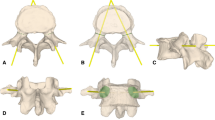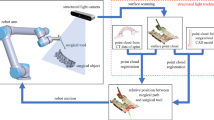Abstract
Purpose
In spinal fusion surgery, imprecise placement of pedicle screws can result in poor surgical outcome or may seriously harm a patient. Patient-specific instruments and optical systems have been proposed for improving precision through surgical navigation compared to freehand insertion. However, existing solutions are expensive and cannot provide in situ visualizations. Recent technological advancement enabled the production of more powerful and precise optical see-through head-mounted displays for the mass market. The purpose of this laboratory study was to evaluate whether such a device is sufficiently precise for the navigation of lumbar pedicle screw placement.
Methods
A novel navigation method, tailored to run on the Microsoft HoloLens, was developed. It comprises capturing of the intraoperatively reachable surface of vertebrae to achieve registration and tool tracking with real-time visualizations without the need of intraoperative imaging. For both surface sampling and navigation, 3D printable parts, equipped with fiducial markers, were employed. Accuracy was evaluated within a self-built setup based on two phantoms of the lumbar spine. Computed tomography (CT) scans of the phantoms were acquired to carry out preoperative planning of screw trajectories in 3D. A surgeon placed the guiding wire for the pedicle screw bilaterally on ten vertebrae guided by the navigation method. Postoperative CT scans were acquired to compare trajectory orientation (3D angle) and screw insertion points (3D distance) with respect to the planning.
Results
The mean errors between planned and executed screw insertion were \(3.38^{\circ }\pm {1.73}^{\circ }\) for the screw trajectory orientation and 2.77±1.46 mm for the insertion points. The mean time required for surface digitization was 125±27 s.
Conclusions
First promising results under laboratory conditions indicate that precise lumbar pedicle screw insertion can be achieved by combining HoloLens with our proposed navigation method. As a next step, cadaver experiments need to be performed to confirm the precision on real patient anatomy.







Similar content being viewed by others
References
Raciborski F, Gasik R, Kłak A (2016) Disorders of the spine. A major health and social problem. Reumatologia 54(4):196
Vos T, Flaxman AD, Naghavi M, Lozano R, Michaud C, Ezzati M, Shibuya K, Salomon JA, Abdalla S, Aboyans V et al (2012) Years lived with disability (ylds) for 1160 sequelae of 289 diseases and injuries 1990–2010: a systematic analysis for the global burden of disease study 2010. The Lancet 380(9859):2163–2196
Van Tulder MW, Koes BW, Bouter LM (1997) Conservative treatment of acute and chronic nonspecific low back pain: a systematic review of randomized controlled trials of the most common interventions. Spine 22(18):2128–2156
Mirza SK, Deyo RA (2007) Systematic review of randomized trials comparing lumbar fusion surgery to nonoperative care for treatment of chronic back pain. Spine 32(7):816–823
Verlaan J, Diekerhof C, Buskens E, Van der Tweel I, Verbout A, Dhert W, Oner F (2004) Surgical treatment of traumatic fractures of the thoracic and lumbar spine: a systematic review of the literature on techniques, complications, and outcome. Spine 29(7):803–814
Maruyama T, Takeshita K (2008) Surgical treatment of scoliosis: a review of techniques currently applied. Scoliosis 3(1):6
Mason A, Paulsen R, Babuska JM, Rajpal S, Burneikiene S, Nelson EL, Villavicencio AT (2014) The accuracy of pedicle screw placement using intraoperative image guidance systems: a systematic review. J Neurosurg Spine 20(2):196–203
Modi HN, Suh SW, Fernandez H, Yang JH, Song HR (2008) Accuracy and safety of pedicle screw placement in neuromuscular scoliosis with free-hand technique. Eur Spine J 17(12):1686–1696
Farshad M, Betz M, Farshad-Amacker NA, Moser M (2017) Accuracy of patient-specific template-guided vs. free-hand fluoroscopically controlled pedicle screw placement in the thoracic and lumbar spine: a randomized cadaveric study. Eur Spine J 26(3):738–749
Merc M, Drstvensek I, Vogrin M, Brajlih T, Recnik G (2013) A multi-level rapid prototyping drill guide template reduces the perforation risk of pedicle screw placement in the lumbar and sacral spine. Arch Orthop Trauma Surg 133(7):893–899
Kantelhardt SR, Martinez R, Baerwinkel S, Burger R, Giese A, Rohde V (2011) Perioperative course and accuracy of screw positioning in conventional, open robotic-guided and percutaneous robotic-guided, pedicle screw placement. Eur Spine J 20(6):860–868
Tian NF, Huang QS, Zhou P, Zhou Y, Wu RK, Lou Y, Xu HZ (2011) Pedicle screw insertion accuracy with different assisted methods: a systematic review and meta-analysis of comparative studies. Eur Spine J 20(6):846–859
Narain AS, Hijji FY, Yom KH, Kudaravalli KT, Haws BE, Singh K (2017) Radiation exposure and reduction in the operating room: perspectives and future directions in spine surgery. World J Orthop 8(7):524
Gebhard FT, Kraus MD, Schneider E, Liener UC, Kinzl L, Arand M (2006) Does computer-assisted spine surgery reduce intraoperative radiation doses? Spine 31(17):2024–2027
Slomczykowski M, Roberto M, Schneeberger P, Ozdoba C, Vock P (1999) Radiation dose for pedicle screw insertion: fluoroscopic method versus computer-assisted surgery. Spine 24(10):975–983
Nottmeier EW, Crosby TL (2007) Timing of paired points and surface matching registration in three-dimensional (3D) image-guided spinal surgery. Clin Spine Surg 20(4):268–270
Richter M, Cakir B, Schmidt R (2005) Cervical pedicle screws: conventional versus computer-assisted placement of cannulated screws. Spine 30(20):2280–2287
Chiang CF, Tsai TT, Chen LH, Lai PL, Fu TS, Niu CC, Chen WJ (2012) Computed tomography-based navigation-assisted pedicle screw insertion for thoracic and lumbar spine fractures. Chang Gung Med J 35(4):332–338
Qian L, Unberath M, Yu K, Fuerst B, Johnson A, Navab N, Osgood G (2017) Towards virtual monitors for image guided interventions-real-time streaming to optical see-through head-mounted displays. arXiv preprint arXiv:171000808
Andress S, Johnson A, Unberath M, Winkler AF, Yu K, Fotouhi J, Weidert S, Osgood G, Navab N (2018) On-the-fly augmented reality for orthopedic surgery using a multimodal fiducial. J Med Imaging 5(2):021209
Sielhorst T, Feuerstein M, Navab N (2008) Advanced medical displays: a literature review of augmented reality. J Disp Technol 4(4):451–467
Navab N, Blum T, Wang L, Okur A, Wendler T (2012) First deployments of augmented reality in operating rooms. Computer 45(7):48–55
Ma L, Zhao Z, Chen F, Zhang B, Fu L, Liao H (2017) Augmented reality surgical navigation with ultrasound-assisted registration for pedicle screw placement: a pilot study. Int J Comput Assis Radiol Surg 12(12):2205–2215
Microsoft (2018) HoloLens Research mode. https://docs.microHrBsoft.com/en-us/windows/mixed-reality/research-modeHrB. Accessed 1 Nov 2018
Olson E (2011) Apriltag: a robust and flexible visual fiducial system. In: 2011 IEEE international conference on robotics and automation (ICRA). IEEE, pp 3400–3407
Wang J, Olson E (2016) Apriltag 2: efficient and robust fiducial detection. In: IROS, pp 4193–4198
Microsoft (2018) Locatable camera. https://docs.microsoft.com/en-us/windows/mixed-reality/locatable-camera. Accessed 5 Nov 2018
Garrido-Jurado S, Muñoz-Salinas R, Madrid-Cuevas FJ, Marín-Jiménez MJ (2014) Automatic generation and detection of highly reliable fiducial markers under occlusion. Pattern Recognit 47(6):2280–2292
Garrido-Jurado S, Munoz-Salinas R, Madrid-Cuevas FJ, Medina-Carnicer R (2016) Generation of fiducial marker dictionaries using mixed integer linear programming. Pattern Recognit 51:481–491
Romero-Ramirez FJ, Muñoz-Salinas R, Medina-Carnicer R (2018) Speeded up detection of squared fiducial markers. Image Vis Comput 76:38–47
Kalman RE (1960) A new approach to linear filtering and prediction problems. J Basic Eng 82(1):35–45
Bradski G, Kaehler A (2000) Opencv. Dr Dobbs journal of software tools 3
Horn BK (1987) Closed-form solution of absolute orientation using unit quaternions. JOSA A 4(4):629–642
Microsoft (2017) Use the HoloLens clicker. https://support.micHrBrosoft.com/de-ch/help/12646/hololens-use-the-hololens-clickerHrB. Accessed 3 Nov 2018
Microsoft (2018) HoloToolkit 2017.4.1.0. https://github.com/MicHrBrosoft/MixedRealityToolkit-Unity/releases/tag/2017.4.1.0HrB. Accessed 3 Nov 2018
Besl PJ, McKay ND (1992) Method for registration of 3-D shapes. In: Sensor fusion IV: control paradigms and data structures, vol 1611. International society for optics and photonics, pp 586–607
Pearson K (1901) LIII. On lines and planes of closest fit to systems of points in space. Lond Edinb Dublin Philos Mag J Sci 2(11):559–572
Schweizer A, Mauler F, Vlachopoulos L, Nagy L, Fürnstahl P (2016) Computer-assisted 3-dimensional reconstructions of scaphoid fractures and nonunions with and without the use of patient-specific guides: early clinical outcomes and postoperative assessments of reconstruction accuracy. J Hand Surg 41(1):59–69
Roner S, Vlachopoulos L, Nagy L, Schweizer A, Fürnstahl P (2017) Accuracy and early clinical outcome of 3-dimensional planned and guided single-cut osteotomies of malunited forearm bones. J Hand Surg 42(12):1031–e1
Walti J, Jost GF, Cattin PC (2014) A new cost-effective approach to pedicular screw placement. In: Workshop on augmented environments for computer-assisted interventions. Springer, pp 90–97
Gibby JT, Swenson SA, Cvetko S, Rao R, Javan R (2019) Head-mounted display augmented reality to guide pedicle screw placement utilizing computed tomography. Int J Comput Assis Radiol Surg 14(3):525–535
Vassallo R, Rankin A, Chen EC, Peters TM (2017) Hologram stability evaluation for microsoft hololens. In: Medical imaging 2017: image perception, observer performance, and technology assessment, vol 10136. international society for optics and photonics, p 1013614
Author information
Authors and Affiliations
Corresponding author
Ethics declarations
Conflict of interest
The authors declare that they have no conflict of interest.
Human and animals rights
This article does not contain any studies with human participants or animals performed by any of the authors.
Patient data
This articles does not contain patient data.
Additional information
Publisher's Note
Springer Nature remains neutral with regard to jurisdictional claims in published maps and institutional affiliations.
Rights and permissions
About this article
Cite this article
Liebmann, F., Roner, S., von Atzigen, M. et al. Pedicle screw navigation using surface digitization on the Microsoft HoloLens. Int J CARS 14, 1157–1165 (2019). https://doi.org/10.1007/s11548-019-01973-7
Received:
Accepted:
Published:
Issue Date:
DOI: https://doi.org/10.1007/s11548-019-01973-7




